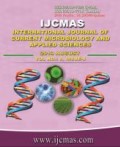


 National Academy of Agricultural Sciences (NAAS)
National Academy of Agricultural Sciences (NAAS)

|
PRINT ISSN : 2319-7692
Online ISSN : 2319-7706 Issues : 12 per year Publisher : Excellent Publishers Email : editorijcmas@gmail.com / submit@ijcmas.com Editor-in-chief: Dr.M.Prakash Index Copernicus ICV 2018: 95.39 NAAS RATING 2020: 5.38 |
Production of biofuels, especially bio-ethanol from lignocellulosic biomass, holds remarkable potential to meet the current energy demand as well as to mitigate greenhouse gas emissions for a sustainable clean environment. Rice is one of the most important agricultural crops in India. Rice straw is an important residue which is generated in large amount in India. Every kilogram of grain harvesting is accompanied by the production of rice straw to a tune of 1.0–1.5 kg. Major proportion of the rice straw is burnt in the field itself. Burning of rice straw in the open fields leads to air pollution and also release particulate matter into the atmosphere. In India 23% of rice straw residue produced is surplus and the greenhouse gas emissions through open field burning constitute 0.05%. Hence, effective utilization of surplus rice straw residue in a sustainable manner with respect to production of bio-ethanol is the need of hour to meet the fast depletion of petroleum fuel and to protect the environment from their rampant practice of open field burning after harvesting. This paper discusses in details the utilization of paddy straw, a potential feed stock for substitution of petroleum based fuel in future.
 |
 |
 |
 |
 |